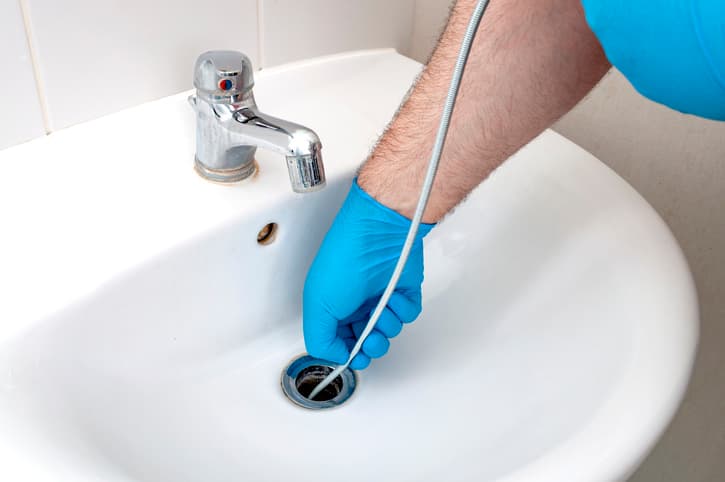While it’s true, you should call a professional plumber for emergencies; some handy homeowners can fix many routine problems. Plungers and baking soda concoctions may do the trick with small blockages; but, for a more significant clog deep inside the line, a drain snake is the next step.
If you plan to use a drain snake, it’s important to understand the best way to get the result you’re looking for. Here are some helpful tips to get you started with a drain snake.
Plumbing the Depths: The Drain Snake
Even if you’re new to drain snakes, you may know that it’s basically a cable that is fed down a drainpipe until it finds a substantial clog to dislodge.
Smaller clogs may flush away when gently prodded — but not most. The snake’s end auger is made to drag obstinate obstructions up through the pipes to be discarded. Unlike using chemicals or a plunger, you’re not necessarily pushing the problem away.
Inside a Drain Snake
The active part of a drain snake is its flexible, extendable metal cable with a cone-shaped auger or hook at the end. The cable is coiled within a protective casing with a handle.
Turning the case’s handle extends the cable, allowing it to lengthen and probe deeply into the drain. The cable turns with the handle inside its casing, and also rotates an auger at its tip. The rotating auger drills into your drain pipe to reach the clog.
Do you have questions about drain snakes? Call the plumbing experts at Larkin Plumbing today.
Types of Drain Snakes
Drain snakes for regular home use are typically from 20 to 50 feet long, though mechanized industrial models have cables of 100 feet or more.
Drain snakes for regular home use are typically from 20 to 50 feet long, though mechanized industrial models have cables of 100 feet or more.
- A basic drain auger is sufficient for most residential projects and isn’t as risky to use as a powered unit. This type is not for use in toilets.
- A toilet auger is similar to a regular auger, but it comes with a protective sleeve to avoid scratching the porcelain. It’s usually shorter and has a thicker cable, too.
- Some snakes can be fitted as an electric drill attachment if you want more power.
What Are Different Kinds of Clogs?
Using a snake is the final step if nothing else works. Here are standard clogs you’ll encounter.
- Most bathtubs have slow-developing clogs from hair and soap. These clogs usually respond to simple solutions, but a drain snake can be necessary if the problem contributes to serious obstruction.
- Sinks have hair and soap problems, but sinks are also prone to having objects dropped inside them — where they can grow into obstructions.
- The most common clogs for toilets are toys and personal sanitation material. Try a plunger first; but, if that doesn’t work, use a specialized toilet auger.
Steps to Properly Use a Drain Snake
A 3/8-inch cable with a length of about 20 feet is plenty for most household clogs. You can probably get the job done with a 1/4-inch snake if that’s all you can find.
Here are the steps:
1 . Lay down towels and put a plastic bucket under any exposed leak. Bring in a flashlight to peer down the drain. It’s essential to wear heavy-duty gloves, such as work gloves; thin latex can get caught in the cable. Also, prepare an empty bucket for clog debris.
2. Feed the auger end into the drain opening. It’s easier to control and monitor if your hand is about 2-3 inches from the drain. If you’re snaking a bathtub drain, feed the auger into the overflow (which usually requires unscrewing the plate).
3. As you turn the handle and extend the cable, the bends in your pipes will offer mild resistance to the auger. Continue to extend the cable until you meet solid resistance that doesn’t budge — that’s the clog. When you meet the blockage, the cable will back up. You should still be able to push forward slightly, unlike against the solid pipe walls.
4. Crank a little more to push the auger into the clog, and gently pull back to hook it. When you feel the extra weight on the cable, you can repeat until the clog disburses, or bring the material up to discard.
5. Cautiously pull the cable out, cranking slowly for safety and control. Carefully bring up any hooked clog debris. Discard the material into your empty bucket, and repeat until the obstruction is removed.
Related: Hiring a Commercial Plumber
Exercise Caution around Drain Snakes
Always be careful with a drain snake. The extended cable develops a lot of recoil energy that can suddenly do surprising, and unfortunate, things.
It is not unheard of for a user’s mistake, or a misdiagnosed drain issue cause a snake to hang up or even snap back. The metal-edged cable can escape the pipe and flail about, and hair and clothing can become entangled and torn.
There are usually no problems with a simple snaking job, but be careful and respect the machine.
Need help with a drain snake? Call the plumbing experts at Larkin Plumbing today.
Working With an Experienced Las Vegas Plumber
If your clog resists chemicals and plungers, snaking the drain is usually the next step. If you have the DIY spirit and want to economize, a well-made and correctly used drain snake can handle many routine clogs.
If you can’t fix the problem with a drain snake—or would prefer not to try—it’s time to call in the professionals. Larkin Plumbing’s 24 hour Las Vegas plumbers can handle whatever clogging issues you’re having: we’re always ready to help get things moving.
Related: What Is a French Drain?

